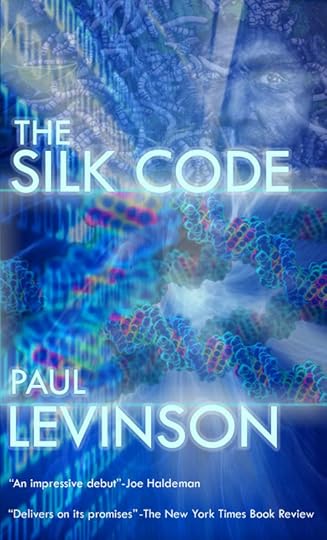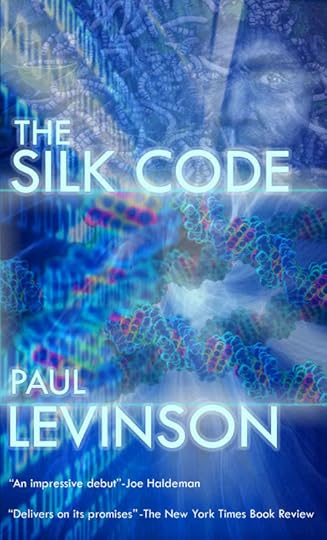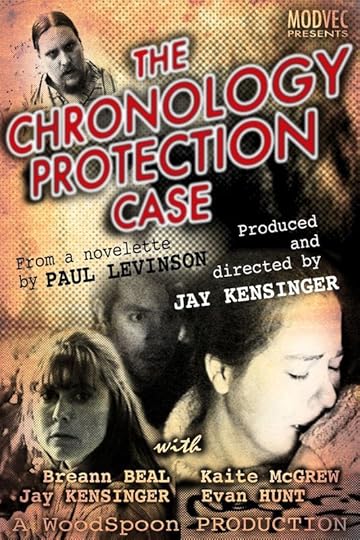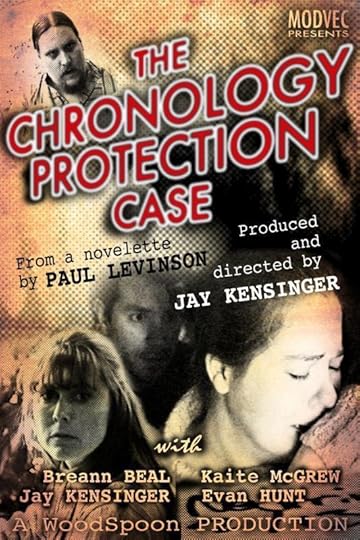Paul Levinson's Blog: Levinson at Large, page 224
March 3, 2017
Colony 2.8: What Passes for a Happy Ending
 Well, nothing ends too happily on Colony, given the alien occupation with the most lethal intentions, but we got about the best we can expect from the ending of episode 2.8 earlier this week.
Well, nothing ends too happily on Colony, given the alien occupation with the most lethal intentions, but we got about the best we can expect from the ending of episode 2.8 earlier this week.The Bowman family is back together. Bram's back home, at last joining Charlie whom Will got back at the beginning of this season, completing the snapshot that Katie held in her hand, of Will and her and Bram, Charlie, and Gracie, before the aliens arrived.
Not only that, but Snyder had his best moment so far, too, saving Bram from the fate that Snyder's factory was accorded due to the alien drone being destroyed - with Bram's help - in episode 2.7. And just for good measure, that irritating tutor was shot dead by the guerrillas who attacked the Bowman house. It was good to see her go.
But ... who were the guerrillas? Given that Will learned that Frankie's mom Karen is the real head of the resistance, my guess is that raid was ordered by Karen, as retribution for Frankie's death. It's great to see Laura Innes back on the screen in this role - and, who knows, maybe she won't turn out to be the villain tonight. (It's possible those Nazis running security did it - but why wouldn't they just send in their police force? Because they didn't want it known by anyone that they killed the Bowmans? Maybe.)
It's also good to see Colony picking up the pace of its narrative, with big changes happening now in every episode. The stakes are higher - much higher than before - and, as Snyder says to Bram, both Snyder and Will are more on the same side than Will might think, with doomsday from the aliens approaching at light speed.
See also Colony 2.1: Prelude ... Colony 2.2: 1969 ... Colony 2.3: The Wall ... Colony 2.7: Countdowns and Intentions
And see also Colony 1.1: Aliens with Potential ... 1.2: Compelling ... 1.5: Questions ... 1.6: The Provost ... Colony 1.7: Broussard ... Colony 1.8: Moon Base and Transit Zones ... Colony 1.9: Robot Arm ... Colony Season 1 Finale: Not Quite Enough

not exactly aliens, but strange enough ... The Silk Code
Paul Levinson's books ... Paul Levinson's music
Published on March 03, 2017 17:53
February 28, 2017
24 Legacy 1.5: Who's Left?
 Well, I was wrong when I predicted last week that Gabriel would be Tony Almeida - indeed not only was Gabriel not that, he didn't even ... [spoiler]
Well, I was wrong when I predicted last week that Gabriel would be Tony Almeida - indeed not only was Gabriel not that, he didn't even ... [spoiler]survive the night (or, the hour, to stay with the 24 structure. And neither did Ben Grimes. Which leaves our side with far fewer possible leads and clues than we might like in 24 Legacy at the end of episode 1.5.
So where does that leave us? I would say Henry Donovan - the Senator's father - is not only the best but pretty much the only live lead our side has. And he seems to be a past master at lying.
We know that he's certainly up to something more than his professed goal of saving and strengthening his son's candidacy. But in with the terrorists? That's pretty extreme.
Of course, in the rich history of 24, we've had plenty of instances in which an American businessman or some such was either the arch-villain or close to it. I'm actually hoping that's not the case for Henry, because well, at least at this point, that seems much too obvious.
But if not Henry, who else? I mean, who else other than the terrorists we've already seen? There's some kind of double-agent still at large at CTU, right, but this person is unlikely to be the head of any terrorist operation.
I'm looking forward to seeing more - meaning, not only future episodes, but a little less of Amira's family, and, for that matter, Eric Carter's, too. Let's get on to the biggest dangers at hand.
See also 24 Legacy 1.1: Dammit! I Liked It ... 24 Legacy 1.2: Heroes and Villains ... 24 Legacy 1.3: First Big Card Revealed ... 24 Legacy 1.4: Who's Gabriel?
Paul Levinson's books ... Paul Levinson's music
Published on February 28, 2017 17:50
Humans 2.3: Motives and Uploads
 An important Humans 2.3 on Monday night, with a look at the motives of Dr. Athena Morrow, and a revelation that her research and work now for Qualia are in pursuit of more than just scientific accomplishment.
An important Humans 2.3 on Monday night, with a look at the motives of Dr. Athena Morrow, and a revelation that her research and work now for Qualia are in pursuit of more than just scientific accomplishment.We discover the Athena's daughter has been in a coma for several years. Her father wants to end it already, but Athena can't bear to do this. That, combined with her AI speaking about a waterfall that appears in a photo of Athena and her daughter that Athena cherishes, put this all into high relief: Athena is investigating and trying to create a form of conscious synthetics - or, as one synth aptly put it, synths that are "awake" - because Athena is hoping to embed in a conscious synch the personality, psyche, or call it soul, of her daughter.
This makes Humans an even more profound narrative about intelligent androids than it was. It's one thing to create conscious synchs out of nothing, or no previous mentality or existing being. I mean, that's incredible indeed, certainly. But employig that digital sophistication to give humans immortality is something quite else, and more.
In a way, this is what motivated Dr. Millican in Season 1. But Athena's seems to be more explicit, and echoes strongly with a novel that hasn't received enough attention over the years - The Silicon Man, a 1991 work by Charles Platt, which explored the form of immortality achieved by uploading someone's mind into a mainframe computer (see my review). It's a theme that has also been explored in many a movie, but The Silicon Man does it best, including the issue of whether it would be murder or suicide or ... to end the fleshy existence of someone whose mentality was uploaded and and from that new ensconcement ordered such termination.
Androids, while not necessarily made of flesh, do have a mobility that Platt's mind in a mainframe didn't have. In effect, putting someone's mind into a synth - Athena's daughter or whoever - may be more akin to cloning than what Platt was playing with. But it will be fun to see where Humans goes with this in any case.
See also Humans 2.1: Westworld meets Nashville ... Humans 2.2: The Consciousness Code
And see also Humans: In Ascending Order ... Humans 1.7: "I Think You're Dead, George"

 Paul Levinson's books ... Paul Levinson's music
Paul Levinson's books ... Paul Levinson's music
Published on February 28, 2017 16:09
February 27, 2017
Black Sails 4.5: Bold Move
 The chess game intensified in Black Sails 4.5, with a truly bold move by Rogers: sail into Spanish Havana, and enlist the aid of England's sworn enemy, in an active state of war with England as almost always in those days, against the pirates in Nassau.
The chess game intensified in Black Sails 4.5, with a truly bold move by Rogers: sail into Spanish Havana, and enlist the aid of England's sworn enemy, in an active state of war with England as almost always in those days, against the pirates in Nassau.At this point there's no point in consulting real history, which tells us the Spanish did indeed try to conquer Nassau at various times, if not precisely this one. For Rogers, it's a dangerous but logical move - the most or only reliable way of crushing the pirates for good.
The scene on the beach with Rackham and Flynt was excellent, too. In this narrative, Rackham has in effect lived so he can deliver that crucial message to Flynt: there's no way, given the blood lust that Rackham has witnessed first hand in Rogers, that the Governor could accede to Eleanor's deal, as much as he does love his wife.
And so a battle of battles is shaping up in Nassau. Flynt was even concerned that the pirates could beat the English. They certainly can't beat the fleet of Spanish ships of war that are approaching the harbor.
The only question left is who will live and who will die in this battle. Again, real history and Robert Louis Stevenson have given some of the major characters a lease on life (that's how I knew that Billy wouldn't be killed Sunday night). On the other hand, who will complain if Black Sails takes a liberty here and there?
I'm awaiting the next episodes.
See also: Black Sails 4.1: "True Friends and Mortal Enemies" ... Black Sails 4.2: Bones vs. Flint ... Black Sails 4.3: Decisive Victories and Losses - On Both Sides ... Black Sails 4.4: Chess Game
See also Black Sails 3.1: Restored ... Black Sails 3.2: Flint vs. Sea ... Black Sails 3.3: Gone Fishin' ... Black Sails 3.4: Mr. Scott's People ... Black Sails 3.5: Alliance ... Black Sails 3.6: The Duel ... Black Sails 3.7: The Blackening of John Silver ... Black Sails 3.8: Whether Vane? ... Black Sails 3.10: Wither Vane ... Black Sails Season 3 Finale: Throckmorton
And see also Black Sails 2.1: Good Combo, Back Story, New Blood ... Black Sails 2.2: A Fine Lesson in Captaining ... Black Sails 2.3: "I Angered Charles Vane" ... Black Sails 2.4: "Fire!" ... Black Sails 2.5: Twist! ... Black Sails 2.6: Weighty Alternatives, and the Medium is the Message on the High Seas ...Black Sails 2.7: The Governor's Daughter and the Gold ... Black Sails 2.9: The Unlikely Hero ... Black Sails Season 2 Finale: Satisfying Literate and Vulgar
And see also Black Sails: Literate and Raunchy Piracy ... Black Sails 1.3: John Milton and Marcus Aurelius ... Black Sails 1.4: The Masts of Wall Street ...Black Sails 1.6: Rising Up ... Black Sails 1.7: Fictions and History ... Black Sails 1.8: Money
#SFWApro

pirates of the mind in The Plot to Save Socrates
Paul Levinson's books ... Paul Levinson's music
Published on February 27, 2017 21:24
Anatomy of an Academy Award Error: The Video Shows Warren Beatty Was Almost a Hero
Warren Beatty has been roundly criticized for wrongly announcing that La La Land (not the actual winner Moonlight) won the Oscar last night for best motion picture (for an especially nasty rendition, see this) - even though Price Waterhouse (I know, it's PriceWaterhouseCoopers, but that doesn't have the pizzazz of the original name) has indicated that it was to blame for giving the wrong envelope to Beatty (details here and here). But if you look at what actually happened on that stage last night, you see that Beatty was not the cause of the error. Indeed, he realized something was wrong, and struggled under the spotlight to correct it. And though he couldn't quite manage to do that, I think he deserves credit for trying.
Here's a video of the televised event with a second-by-second timeline:
.06-14 seconds: Beatty looks in the envelop, and realizes something is wrong (he later explains, and Price Waterhouse acknowledges, that what's in the envelope is the card announcing Emma Stone winning best actress for La La Land). He's likely looking to see if there's another announcement card - one for the best motion picture.
.14-16 seconds: Beatty turns to Faye Dunaway, hoping she might have some idea about what's going on, but she just gives him a reproachful look, thinking he's horsing around at the wrong time.
.17 seconds: Feeling the pressure, Beatty begins to announce, "And the Academy Award..." But he can't bring himself to finish, because he knows something is not right.
.20 seconds: Beatty looks down again at the card, thinking maybe he missed something.
.21-.25 seconds: Beatty says "for best picture..." He looks past Dunaway, desperately hoping, again, for some guidance from someone off-stage. Dunaway, still thinking he's joking, says "You're impossible."
.26-29 seconds: Beatty, unable to continue, because he knows something is wrong, gives the envelope to Dunaway, who barely glances at the errant card, and announces "La La Land"
So ... we still need to find out how exactly Price Waterhouse - or the people or person at Price Waterhouse - came to give Beatty the wrong envelope (Russian hacking, maybe? - I'm only joking) (mostly) (he did direct, co-write, and star in Reds). But, Warren Beatty can hold his head up, if not high, at least not too low, as someone who struggled with tens of millions of people watching him, to do the right thing, under incredible pressure.
Once upon a time, prior to the digital age, a mistake made on television and wrongly attributed left the non-culprit with little recourse, totally at the mercy of the "professional" critics who sounded off today. But also today, videos on YouTube show the truth. Beatty wasn't a villain last night - to the contrary, he was almost a hero.
Paul Levinson's books ... Paul Levinson's music
Here's a video of the televised event with a second-by-second timeline:
.06-14 seconds: Beatty looks in the envelop, and realizes something is wrong (he later explains, and Price Waterhouse acknowledges, that what's in the envelope is the card announcing Emma Stone winning best actress for La La Land). He's likely looking to see if there's another announcement card - one for the best motion picture.
.14-16 seconds: Beatty turns to Faye Dunaway, hoping she might have some idea about what's going on, but she just gives him a reproachful look, thinking he's horsing around at the wrong time.
.17 seconds: Feeling the pressure, Beatty begins to announce, "And the Academy Award..." But he can't bring himself to finish, because he knows something is not right.
.20 seconds: Beatty looks down again at the card, thinking maybe he missed something.
.21-.25 seconds: Beatty says "for best picture..." He looks past Dunaway, desperately hoping, again, for some guidance from someone off-stage. Dunaway, still thinking he's joking, says "You're impossible."
.26-29 seconds: Beatty, unable to continue, because he knows something is wrong, gives the envelope to Dunaway, who barely glances at the errant card, and announces "La La Land"
So ... we still need to find out how exactly Price Waterhouse - or the people or person at Price Waterhouse - came to give Beatty the wrong envelope (Russian hacking, maybe? - I'm only joking) (mostly) (he did direct, co-write, and star in Reds). But, Warren Beatty can hold his head up, if not high, at least not too low, as someone who struggled with tens of millions of people watching him, to do the right thing, under incredible pressure.
Once upon a time, prior to the digital age, a mistake made on television and wrongly attributed left the non-culprit with little recourse, totally at the mercy of the "professional" critics who sounded off today. But also today, videos on YouTube show the truth. Beatty wasn't a villain last night - to the contrary, he was almost a hero.
Paul Levinson's books ... Paul Levinson's music
Published on February 27, 2017 09:52
February 26, 2017
The Chronology Protection Case short movie now FREE on Amazon Prime

from the 1995 Nebula-nominated novelette, reprinted five times,
adapted into Edgar-nominated radio play ... here's the movie, first
released in 2002, re-cut with new, extended ending in 2013, now
available FREE on Amazon Prime for first time Paul Levinson's books ... Paul Levinson's music
Published on February 26, 2017 21:12
The Break (La Trêve): Riveting Belgian Whodunnit, But
 My wife and I streamed The Break - the English title for the 2016 Belgian La trêve noir police procedural on Netflix - and thought it was excellent, even great, until the end. Though even then The Break had its moments.
My wife and I streamed The Break - the English title for the 2016 Belgian La trêve noir police procedural on Netflix - and thought it was excellent, even great, until the end. Though even then The Break had its moments.The story is about a high-school soccer-player suicide, which, of course, quickly turns out not to be a suicide. Yoann Peeters (very well played by Yoann Blanc), in this small town after a case that went very bad in Brussels, catches this investigation. The local police are mostly earnest, somewhat bumbling, and by-and-large competent. Suspects are manifold, and the narrative develops with lots of twists and turns and surprises. [From here on there'll be lots of spoilers, so read on either if you don't care or have already seen the series.]
The power of the narrative comes from the likely and unlikely suspects who are revealed and then turn out, for one reason or another, not to have done the deed. This is the part of the story that makes it a top-notch, powerful whodunnit.
But a story like this requires an equally powerful, plausible ending. And though the end is powerful, it opens up a huge pothole in the plot. Inès, Yoann's high-school sweetheart (he grew up in the area), is a great choice for the villain, since that delivers such an emotional punch to Yoann and the viewers. She's been Yoann's lifeline for a lot of the story, resisting his entreaties to get back together again at first, and now that they're together again her revelation as killer is emotional dynamite.
But ... why would she, as the killer, have been the one to show Yoann, early on, that Driss (the victim) couldn't have written the suicide note, since he didn't have the written skills? Wouldn't Inès have wanted the case closed as a suicide, as soon as possible?
We could come up with reasons - Inès felt guilty, she wanted Yoann to investigate the death because she loved him and thought Yoann's active investigation was the best way of keeping him around - but we shouldn't have to come up with motives like that, especially when there was another, much better, candidate for the killer, the police chief, who indeed did do his best at first to close the case as a suicide.
But The Break is nonetheless a riveting 10-episode series, and well worth your viewing.
Paul Levinson's books ... Paul Levinson's music
Published on February 26, 2017 11:28
February 25, 2017
Upstream Color: Upscale Biological Science Fiction
 I finally got around to streaming Upstream Color, the 2013 and second movie by Primer (2004) creator Shane Carruth, who, as Wikipedia aptly puts it, also wrote, directed, produced, edited and scored the movie, and stars in the main role, as well.
I finally got around to streaming Upstream Color, the 2013 and second movie by Primer (2004) creator Shane Carruth, who, as Wikipedia aptly puts it, also wrote, directed, produced, edited and scored the movie, and stars in the main role, as well.The two movies therefore, unsurprisingly, have a lot in common, including brilliantly, carefully plotted, complex stories, minimal exposition in dialogue, and a low-key ambience that goes far below and deeper than just low-budget. But the two are also very different - not only because Primer is about time-travel, and Upstream Color is about, well, I'll get to that in a moment, but because Upstream Color has a much richer emotional current.
And, actually, that current gets to what Upstream Color is and is about. It's a relative rarity in science fiction movies - unlike time travel - a highly literate, philosophical kind of biological science fiction. Biology in science fiction is common - we encounter it every time we see a movie about a mutation gone amok, and often in narratives about aliens. In many cases, such movies are pulp-horror or superhero stories.
There is a horror in Upstream Color, but it's more quiet, under the surface, and therefore disconcerting if not viscerally frightening, though Upstream Color has some of that, too. The story, in a nutshell, is a about a worm-like organism, whose life cycle entails orchids, pigs, and human beings. As in all parasitic life cycles - a real part of our natural world, not just science fiction - the hosts do their thing, live their lives, with little or no awareness that they're doing the parasite's biological bidding. Upstream Color explores this, harrowingly, subtly, compellingly, for humans, including our two central characters (with good work by Amy Seimetz as Carruth's character's partner), who discover a powerful attraction to one another, and various people ranging from a swindler who's also a kidnapper to pig farmers and gardeners.
The result is an indelible Blue Velvet-like tableau of life under the surface, which feels incomplete, just as did Primer. But that's part of the power and charm of these movies.

a different kind of biological science fiction Paul Levinson's books ... Paul Levinson's music
Published on February 25, 2017 11:54
February 24, 2017
Colony 2.7: Countdowns and Intentions
 Colony 2.7 really got down to nasty brass tacks last night, with an episode that revealed all sorts of tidbits and bigger things about what's really going on.
Colony 2.7 really got down to nasty brass tacks last night, with an episode that revealed all sorts of tidbits and bigger things about what's really going on.First, we learned more about what we were teased about a few episodes back - the aliens have been in our vicinity since 1969, counting down to the Arrival. And by the end of the episode, we learn two other things: the aliens are shipping humans off planet, to be eaten or who knows what, and there is another countdown in motion for when the extermination of all humans on Earth will be completed.
That end date is just a few years away, and ups the ante for what our heroes need to do. They have less time that the usual run for many science fiction series on television to stop the invaders. (Of course, the series could run longer, if need be.)
But we still don't quite know the nature of what the aliens expect to do with the humans, or human bodies, that they're packing up and sending off-planet. I said "eat," which would make Colony an extended version of "To Serve Man" (classic Damon Knight story made into a classic Twilight Zone episode), but we don't really know. Clearly, the aliens are not just incinerating humans on Earth. They're putting some effort into getting their quarry with bodies intact off-planet. It will be interesting to see more of the alien plans.
Meanwhile, as knowledge spreads among our human characters of what the aliens are really up to - planning our elimination, for whatever reason - this is bound to bring humans, at least most of us, together. Surely Katie's sister and her greedy husband won't want to go along the aliens, and neither will Snyder. (Some of those new guys in the police state are so far gone, there's no telling what they'll do.)
Bram's helping with the blowing up of the alien ship has a lit a strong fuse. The repercussions should set the rest of the season in exciting turmoil.
See also Colony 2.1: Prelude ... Colony 2.2: 1969 ... Colony 2.3: The Wall
And see also Colony 1.1: Aliens with Potential ... 1.2: Compelling ... 1.5: Questions ... 1.6: The Provost ... Colony 1.7: Broussard ... Colony 1.8: Moon Base and Transit Zones ... Colony 1.9: Robot Arm ... Colony Season 1 Finale: Not Quite Enough

not exactly aliens, but strange enough ... The Silk Code Paul Levinson's books ... Paul Levinson's music
Published on February 24, 2017 12:25
Science Fiction in Person in New York in March
March is shaping up to be a break-out month for science fiction in the flesh - or at in-person events - in the New York area. Here are three where I'll be talking about all sorts of wild and profound things:
March 1, 6-9pm, "Science Fiction, Language, and General Semantics," panel with Paul Levinson, Ed Tywoniak, Marleen Barr, and Lance Strate - for the New York Society of General Semantics, at The Players Club, 16 Gramercy Park S., New York City - admission FREE - details hereMarch 4, 12noon-2pm, "Why the Impossibility of Time Travel Makes Such Good Fiction," I'll be talking for at least an hour, to the Garden State Speculative Fiction Writers, and then we'll go to questions and answers - Old Bridge Public Library, One Old Bridge Plaza, Municipal Center, Old Bridge, NJ -admission FREE - details hereMarch 10-12, HELIOsphere, DoubleTree by Hilton Hotel Tarrytown, 455 South Broadway, Tarrytown, New York - my events: FRIDAY (March 10) 5:30pm - 7:00pm - "Religion in Sci Fi and Fantasy" (panel); SATURDAY (March 11) 2:30pm - 4:00pm - "Robots 201: After the Three Laws" (panel) ; SUNDAY (March 12) 12noon - 1:30pm - Westworld and the Civil Rights of Robots" (solo talk); reading & autographing (times to be announced) - details hereAnd, just to whet your appetite for some of what I'll be discussing re: time travel, The Chronology Protection Case movie just became free on Amazon Prime. It's a 40-minute short, adapted by Jay Kensinger from my 1995 Nebula-nominated novelette published in Analog, and reprinted six times. The movie was made in 2002 but has been recut with a new, extended ending. (The original novelette is available here.)

Paul Levinson's books ... Paul Levinson's music
March 1, 6-9pm, "Science Fiction, Language, and General Semantics," panel with Paul Levinson, Ed Tywoniak, Marleen Barr, and Lance Strate - for the New York Society of General Semantics, at The Players Club, 16 Gramercy Park S., New York City - admission FREE - details hereMarch 4, 12noon-2pm, "Why the Impossibility of Time Travel Makes Such Good Fiction," I'll be talking for at least an hour, to the Garden State Speculative Fiction Writers, and then we'll go to questions and answers - Old Bridge Public Library, One Old Bridge Plaza, Municipal Center, Old Bridge, NJ -admission FREE - details hereMarch 10-12, HELIOsphere, DoubleTree by Hilton Hotel Tarrytown, 455 South Broadway, Tarrytown, New York - my events: FRIDAY (March 10) 5:30pm - 7:00pm - "Religion in Sci Fi and Fantasy" (panel); SATURDAY (March 11) 2:30pm - 4:00pm - "Robots 201: After the Three Laws" (panel) ; SUNDAY (March 12) 12noon - 1:30pm - Westworld and the Civil Rights of Robots" (solo talk); reading & autographing (times to be announced) - details hereAnd, just to whet your appetite for some of what I'll be discussing re: time travel, The Chronology Protection Case movie just became free on Amazon Prime. It's a 40-minute short, adapted by Jay Kensinger from my 1995 Nebula-nominated novelette published in Analog, and reprinted six times. The movie was made in 2002 but has been recut with a new, extended ending. (The original novelette is available here.)

Paul Levinson's books ... Paul Levinson's music
Published on February 24, 2017 11:38
Levinson at Large
At present, I'll be automatically porting over blog posts from my main blog, Paul Levinson's Infinite Regress. These consist of literate (I hope) reviews of mostly television, with some reviews of mov
At present, I'll be automatically porting over blog posts from my main blog, Paul Levinson's Infinite Regress. These consist of literate (I hope) reviews of mostly television, with some reviews of movies, books, music, and discussions of politics and world events mixed in. You'll also find links to my Light On Light Through podcast.
...more
- Paul Levinson's profile
- 342 followers



